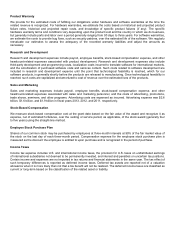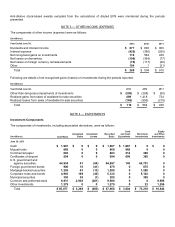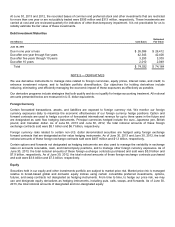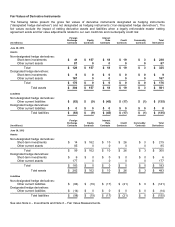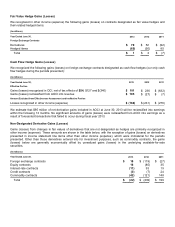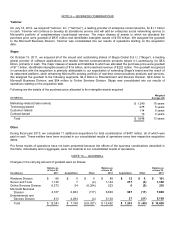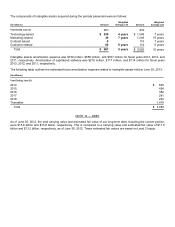Microsoft 2013 Annual Report Download - page 56
Download and view the complete annual report
Please find page 56 of the 2013 Microsoft annual report below. You can navigate through the pages in the report by either clicking on the pages listed below, or by using the keyword search tool below to find specific information within the annual report.
At June 30, 2013 and 2012, the recorded bases of common and preferred stock and other investments that are restricted
for more than one year or are not publicly traded were $395 million and $313 million, respectively. These investments are
carried at cost and are reviewed quarterly for indicators of other-than-temporary impairment. It is not practicable for us to
reliably estimate the fair value of these investments.
Debt Investment Maturities
(In millions)
Cost Basis
Estimated
Fair Value
June 30, 2013
Due in one year or less
$ 26,386
$ 26,412
Due after one year through five years
42,343
42,400
Due after five years through 10 years
3,293
3,303
Due after 10 years
2,010
2,049
Total
$ 74,032
$ 74,164
NOTE 5 — DERIVATIVES
We use derivative instruments to manage risks related to foreign currencies, equity prices, interest rates, and credit; to
enhance investment returns; and to facilitate portfolio diversification. Our objectives for holding derivatives include
reducing, eliminating, and efficiently managing the economic impact of these exposures as effectively as possible.
Our derivative programs include strategies that both qualify and do not qualify for hedge accounting treatment. All notional
amounts presented below are measured in U.S. dollar equivalents.
Foreign Currency
Certain forecasted transactions, assets, and liabilities are exposed to foreign currency risk. We monitor our foreign
currency exposures daily to maximize the economic effectiveness of our foreign currency hedge positions. Option and
forward contracts are used to hedge a portion of forecasted international revenue for up to three years in the future and
are designated as cash flow hedging instruments. Principal currencies hedged include the euro, Japanese yen, British
pound, and Canadian dollar. As of June 30, 2013 and June 30, 2012, the total notional amounts of these foreign
exchange contracts sold were $5.1 billion and $6.7 billion, respectively.
Foreign currency risks related to certain non-U.S. dollar denominated securities are hedged using foreign exchange
forward contracts that are designated as fair value hedging instruments. As of June 30, 2013 and June 30, 2012, the total
notional amounts of these foreign exchange contracts sold were $407 million and $1.3 billion, respectively.
Certain options and forwards not designated as hedging instruments are also used to manage the variability in exchange
rates on accounts receivable, cash, and intercompany positions, and to manage other foreign currency exposures. As of
June 30, 2013, the total notional amounts of these foreign exchange contracts purchased and sold were $5.0 billion and
$7.9 billion, respectively. As of June 30, 2012, the total notional amounts of these foreign exchange contracts purchased
and sold were $3.6 billion and $7.3 billion, respectively.
Equity
Securities held in our equity and other investments portfolio are subject to market price risk. Market price risk is managed
relative to broad-based global and domestic equity indices using certain convertible preferred investments, options,
futures, and swap contracts not designated as hedging instruments. From time to time, to hedge our price risk, we may
use and designate equity derivatives as hedging instruments, including puts, calls, swaps, and forwards. As of June 30,
2013, the total notional amounts of designated and non-designated equity





